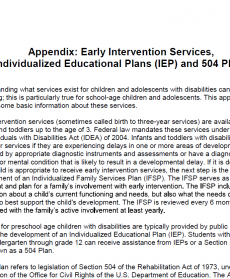Understanding what services exist for children and adolescents with disabilities can be very confusing; this is particularly true for school-age children and adolescents. This appendix will provide some basic information about these services.
Early intervention services (sometimes called birth to three-year services) are available to infants and toddlers up to the age of 3. Federal law mandates these services under Part C of the Individuals with Disabilities Act (IDEA) of 2004. Infants and toddlers with disabilities may qualify for services if they are experiencing delays in one or more areas of development as measured by appropriate diagnostic instruments and assessments or have a diagnosed physical or mental condition that is likely to result in a developmental delay. If it is determined that a child is appropriate to receive early intervention services, the next step is the development of an Individualized Family Services Plan (IFSP). The IFSP serves as the document and plan for a family’s involvement with early intervention. The IFSP includes information about a child’s current functioning and needs, but also what the needs of the family may be to best support the child’s development. The IFSP is reviewed every 6 months and must be updated with the family’s active involvement at least yearly.
Services for preschool age children with disabilities are typically provided by public schools through the development of an Individualized Educational Plan (IEP). Students with disabilities from kindergarten through grade 12 can receive assistance from IEPs or a Section 504 Plan, also known as a 504 Plan.
A 504 Plan refers to legislation of Section 504 of the Rehabilitation Act of 1973, under the supervision of the Office for Civil Rights of the U.S. Department of Education. The Act is a broad federal civil rights law that protects individuals with disabilities against discrimination, including in the school setting. A 504 Plan describes how a child with disabilities will have access to services, accommodations, and modifications to the learning environment to access the general education as adequately as students without disabilities. Disability is described broadly in Section 504. To qualify for a 504 Plan, a student must have (1) a physical or mental impairment that substantially limits one or more major life activities; or (2) have a record of such an impairment; or (3) be regarded as having such an impairment [Section 504 regulatory provision at 34 C.F.R. 104.35]. The definitions of impairment and what is meant by substantially limiting major life activities are quite broad compared to requirements to qualify for an IEP. An evaluation by the school is necessary before it can be determined if a child is eligible for a 504 Plan. However, that evaluation can be informal, with information gathered from a variety of sources, instead of the school performing a formal evaluation as required for an IEP.
The current version of the Individuals with Disabilities Act (IDEA) allows children and adolescents with disabilities to receive special services in school through an IEP. To qualify for an IEP, a child must have one or more of 13 specific disabilities listed in IDEA. Most children with Spina Bifida will qualify under one or more of these, including “multiple disabilities,” “orthopedic impairment,” “other health impairment,” or “specific learning disability.” (Note: non-verbal learning disabilities are NOT recognized as one of the specific learning disabilities. Thus, a category like “other health impairment” is preferred.) In addition, the disability must affect the child’s educational performance or ability to learn and benefit from the general educational curriculum, requiring a need for specially-designed instruction, not just accommodations or modifications.
A student cannot have both an IEP and a 504 Plan. If a student qualifies for an IEP, all the support accommodations and modifications which might be provided by a 504 Plan are incorporated into an IEP.
For more information, please review the following materials:
Tags


